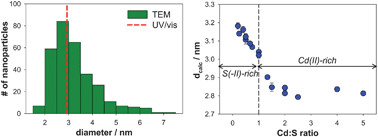Spectroscopic determination of the size of cadmium sulfide nanoparticles formed under environmentally relevant conditions
Abstract
A multi-technique approach was adopted using UV/

a Department of Chemistry and Biochemistry, University of Delaware, Newark, Delaware, USA
b
College of Earth, Ocean and Environment, University of Delaware, Lewes, Delaware, USA
E-mail:
luther@udel.edu
Fax: +1 302 645 4007
Tel: +1 302 645 4208
A multi-technique approach was adopted using UV/

 Please wait while we load your content...
Something went wrong. Try again?
Please wait while we load your content...
Something went wrong. Try again?
K. M. Mullaugh and G. W. Luther, III, J. Environ. Monit., 2010, 12, 890 DOI: 10.1039/B919917A
To request permission to reproduce material from this article, please go to the Copyright Clearance Center request page.
If you are an author contributing to an RSC publication, you do not need to request permission provided correct acknowledgement is given.
If you are the author of this article, you do not need to request permission to reproduce figures and diagrams provided correct acknowledgement is given. If you want to reproduce the whole article in a third-party publication (excluding your thesis/dissertation for which permission is not required) please go to the Copyright Clearance Center request page.
Read more about how to correctly acknowledge RSC content.
 Fetching data from CrossRef.
Fetching data from CrossRef.
This may take some time to load.
Loading related content
